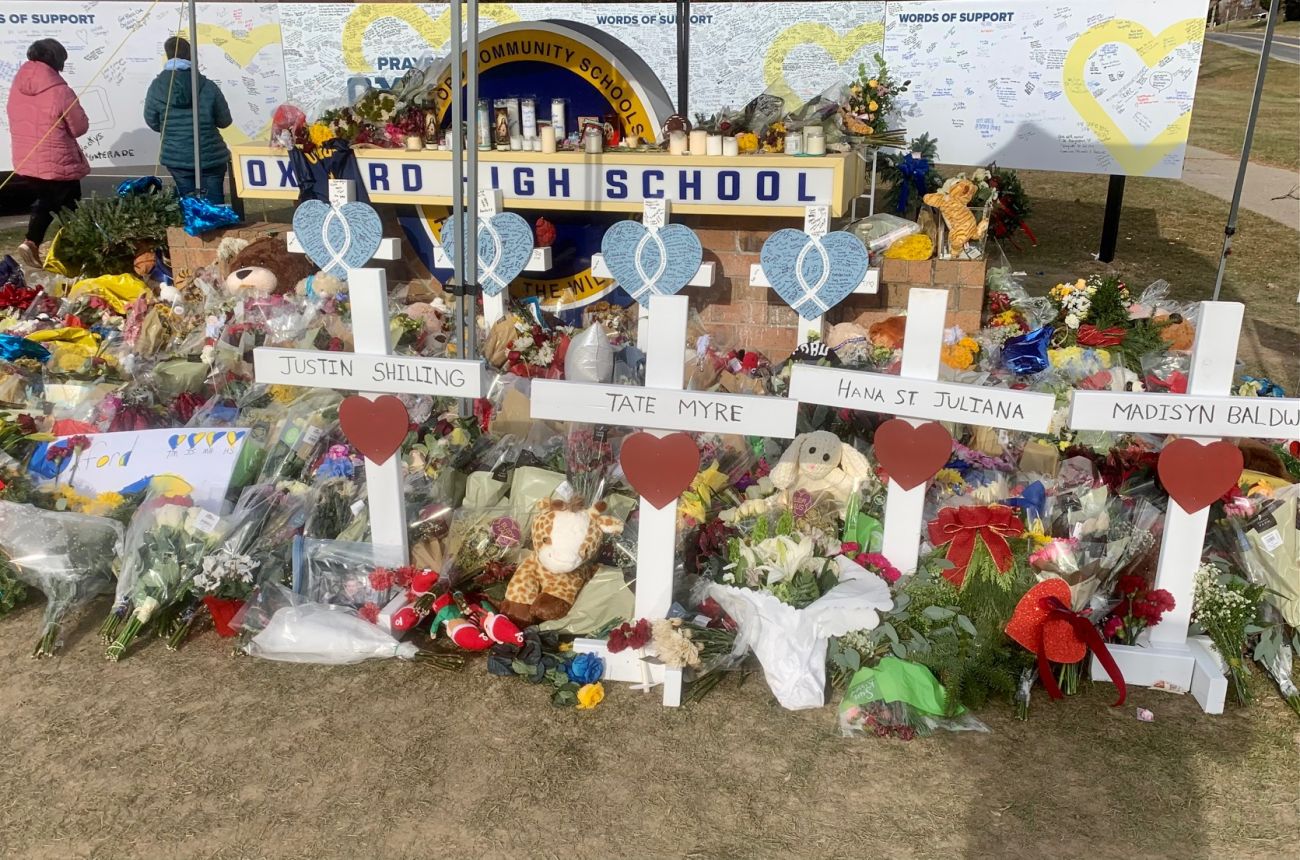Oxford shooting probe: Three takeaways to improve Michigan school safety

- A new investigation of the Oxford High School shooting found school employees failed to recognize that a student’s behavior suggested he might cause harm at the school
- The student would go on to shoot and kill four people and injure seven others
- Michigan superintendents said the shooting provided lessons on student threat assessments and communications with law enforcement
An exhaustive investigation into the Oxford High School shooting found administrators and counselors failed to follow safety protocols and missed several warning signs before the 2021 tragedy.
Guidepost Solutions, a firm hired by the district, released a nearly 600-page report Monday night that faulted a host of staffers including a former superintendent who didn’t implement threat assessment guidelines for his staff, and a guidance counselor who allowed the shooter to return to class the day of the shooting after meeting him and his parents about his behavior.
The district also had security measures in place, such as live video feeds, but failed to monitor them during the rampage on Nov. 30 2021.
Learn more about Oxford
You can read the full investigative report here. Guidepost’s investigative team will answer questions at meetings at 1 p.m., 3:30 p.m. and 6:30 p.m. Thursday in the Oxford Township Board Room, 300 Dunlap Road, Oxford, MI 48371.
Those with questions are encouraged but not required to submit questions to oxford@guidepostsolutions.com.
“While we did not find intention, or callousness, or wanton indifference, we did find failure and responsibility by omission,” the report reads. “In short, responsibility too often was denied and shifted elsewhere. Taken together, when responsibility everywhere rests elsewhere, it rests nowhere.”
Related:
- New report provides safety recommendations for Oxford High after shooting
- What Michigan State asked, and didn’t ask, in its review of campus shooting
- In Las Vegas, firms pitch mass-shooter security to schools. Does it work?
The former student has pleaded guilty to killing classmates Madisyn Baldwin and Justin Shilling, both 17, Tate Myre, 16, and Hana St. Juliana, 14, and injuring seven others.
Superintendents told Bridge Michigan on Monday before the report’s release they had strengthened protocols of identifying at-risk students and trained staff on how to better handle threat assessments.
“I’m trying to do everything we can to prevent this from happening,” said Niles Community Schools Superintendent Dan Applegate.
Here are three lessons from the report.
Lesson 1: Improve process and threat assessments
The investigators found that Oxford counselor Shawn Hopkins and Dean of Students Nick Ejak had “sufficient warning signs and red flags” on the day of the shooting that “should have led them to elevate the Shooter’s conduct and communications to a principal or assistant principal.”
The report said the counselor failed to follow the district’s suicide intervention protocol and ask if the student had access to a weapon even though they determined he was a threat to himself. As it happened, the student had a handgun in his backpack that he used that day to carry out the killings.
The report says the counselor and dean shouldn’t have allowed the shooter to return to class after he was sent to the office for watching a violent video, making drawings of a gun and writing the words “blood everywhere” and “help me.”
Investigators found the district “failed to adopt and implement threat assessment guidelines” and a suicide intervention policy. They found the district didn’t provide enough training so that employees knew how the threat assessment process worked.
Monday’s report followed one by Guidepost that found the district’s current threat assessments were enforced at an “unsustainable” rate, recommending go-to-people at each school to filter reports of concerning student behavior and then elevate concerns to the full threat assessment team. Since that report, the Oxford district has made changes to its threat assessment protocols and other safety measures.
“There's always more and sometimes that more doesn't get detected, unfortunately, until after a situation,” said Applegate, the Niles superintendent.
The Oxford shooting “absolutely, without a doubt” affected Redford Union Schools’ safety approach, Superintendent Jasen Witt told Bridge.
Witt said his district has worked to ensure procedures around student threat assessments are consistent.
He wants to ensure that counselors, social workers and deans are able to respond to student behavior concerns. These people must also know to involve building administrators and sometimes school resource officers in these threat assessments, he said.
Mark Greathead, superintendent of Woodhaven-Brownstown School District, said these assessments are “one of the single most important things that school districts can and should be doing in providing that safe environment.”
Lesson 2: Use available technology
Investigators found that Oxford had adequate school video security systems, but they weren’t properly used.
The school’s system carried live feeds, but no one monitored them, preventing the school from broadcasting warning messages about the shooter’s location.
The report said the public announcement system was not designed for emergency communications and that “at the time of the shooting, both primary security staff members were offsite.”
The district has updated its camera system to include artificial intelligence technology to detect weapons. The current public address system speakers have been tested and updated, but the district appears to be adding a mass notification system to the existing system as well.
At Michigan State University, where a gunman killed three students in February, officials updated outdoor alarm systems to allow broadcasts of emergency messages. Administrators are in the process of updating cameras to allow real-time monitoring.
Redford Union schools also added secure vestibules, and Witt said the district has increased security staffing from 15 positions last year to 18 positions and a security manager this year.
Since the Oxford shooting, Michigan lawmakers have dedicated hundreds of millions of dollars to help schools bolster security, including classroom door barricade devices, weapon detection software and independent safety assessments.
In the summer following the Oxford shooting, lawmakers approved $12.5 million for in-depth school maps designed to help law enforcement in case of an emergency.
That mapping, along with listening to the scanner during the MSU shooting, helped Applegate realize the importance of ensuring police know how classrooms and parts of the school are referred to by students and teachers.
Lesson 3: Investigations painful but necessary
The independent report was released almost two years after the Oxford shooting and followed much consternation and resistance.
The Oxford school board had initially sought to delay an independent probe until lawsuits against the district were settled. Still, nearly half of the 160 people Guidepost sought to interview did not make themselves available.
Also, lawyers for the district and teacher union encouraged people to not participate in the investigation, according to the report.
“We will never know, nor will we count, the victims who were saved by better plans and procedures, but the failure to have those better plans and procedures leaves an unacceptable vulnerability,” the report read.
The report was released two weeks after Michigan State University announced the findings from an independent report into its school shooting.
MSU sought a review that outlined “what response actions (it) handled well and what actions may be improved.” The 25-page report that followed includes few details about errors in the school’s response the night of the shooting.
The investigators hired by MSU also reported they weren’t able to interview “some law enforcement officers” but did not offer specifics.
Still, law enforcement and school safety experts have previously told Bridge that after action analysis on mass shootings can help leaders prevent tragedies.
Witt, the superintendent at Redford Union, said the latest Oxford report showed that if procedures had been followed, the shooting may have been avoided.
“It just reinforces how important it is to have a consistent behavior threat assessment process that staff understand,” he said.
Greathead, the Woodhaven-Brownstown superintendent, said Monday the learning isn’t done.
“It's a constant state of learning for us in this area: trying to make sure that we are staying as prudent as possible to keep our students and staff safe while they’re here at school with us,” Greathead said.
How to get help
If you need mental health support, call or text 988 to reach the confidential Suicide & Crisis Lifeline, a 24-hour network of more than 200 local crisis centers throughout the country. You can chat online with a counselor at www.988lifeline.org.
Other resources include:
- The Michigan Crisis and Action Hotline (MiCAL)
- Call or text 988
- 24/7
- Free and confidential
- Amala – The Muslim Youth Hopeline:
- Phone (855) 95 AMALA or (855) 952-6252
- Hours: M, W, F, Sat, and Sun from 6 p.m. to 10 p.m.
- Mental Health America
- Text MHA to 741741
- Free text based support 24/7
- National Drug & Alcohol Abuse Hotline
- (800) 662-HELP (4357)
- 24/7
- Free and confidential
- English and spanish
- Online treatment locator
- Trevor Project (LGBTQ)
- Phone: (866) 488-7386
- Text: 678 678
- Webchat
- 24/7
- Youth Crisis Line (Text/talk/chat)
- (800) 843-5200
- 24/7
- Veterans Crisis Line
- Phone: 988 Press 1
- Text: 838255
- Chat online
Worried about someone?
- Know the Signs: (800) 273-8255
- The Michigan Crisis and Action Hotline (MiCAL)
- Call or text 988
- 24/7
- Free and confidential
Michigan Education Watch
Michigan Education Watch is made possible by generous financial support from:
Subscribe to Michigan Health Watch
See what new members are saying about why they donated to Bridge Michigan:
- “In order for this information to be accurate and unbiased it must be underwritten by its readers, not by special interests.” - Larry S.
- “Not many other media sources report on the topics Bridge does.” - Susan B.
- “Your journalism is outstanding and rare these days.” - Mark S.
If you want to ensure the future of nonpartisan, nonprofit Michigan journalism, please become a member today. You, too, will be asked why you donated and maybe we'll feature your quote next time!





